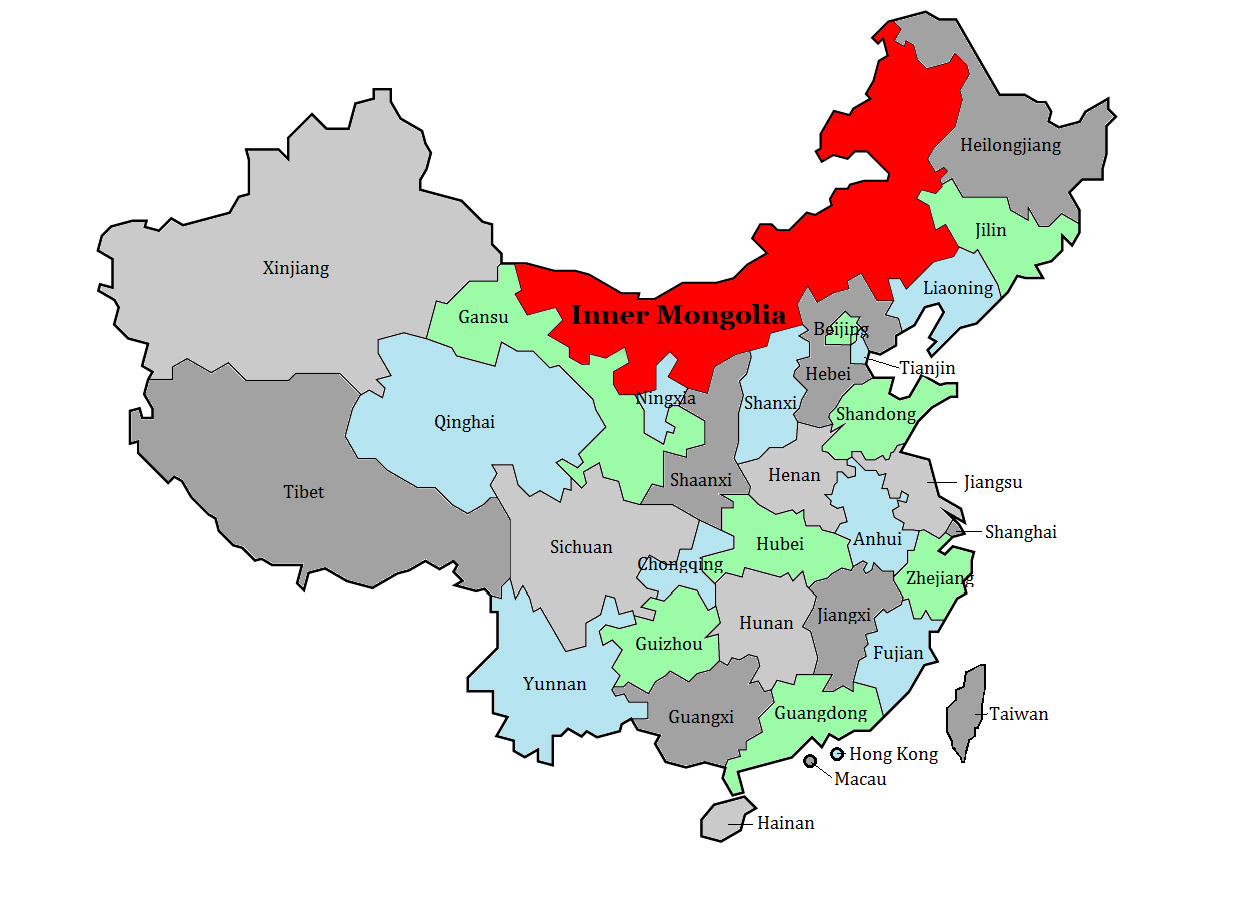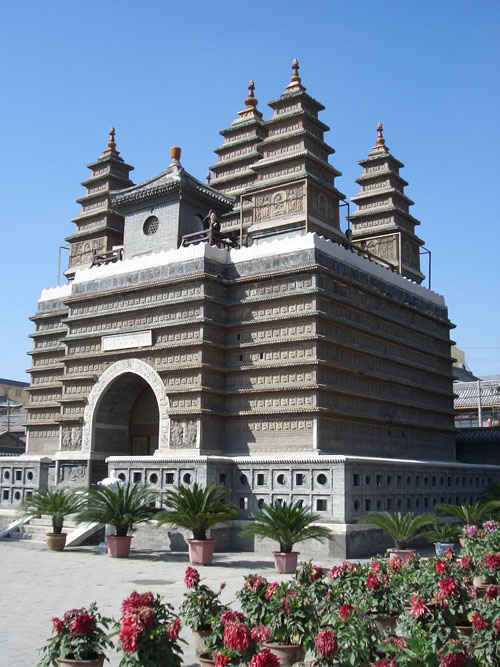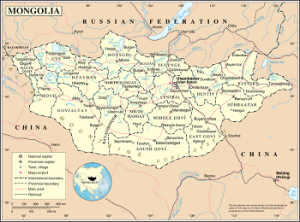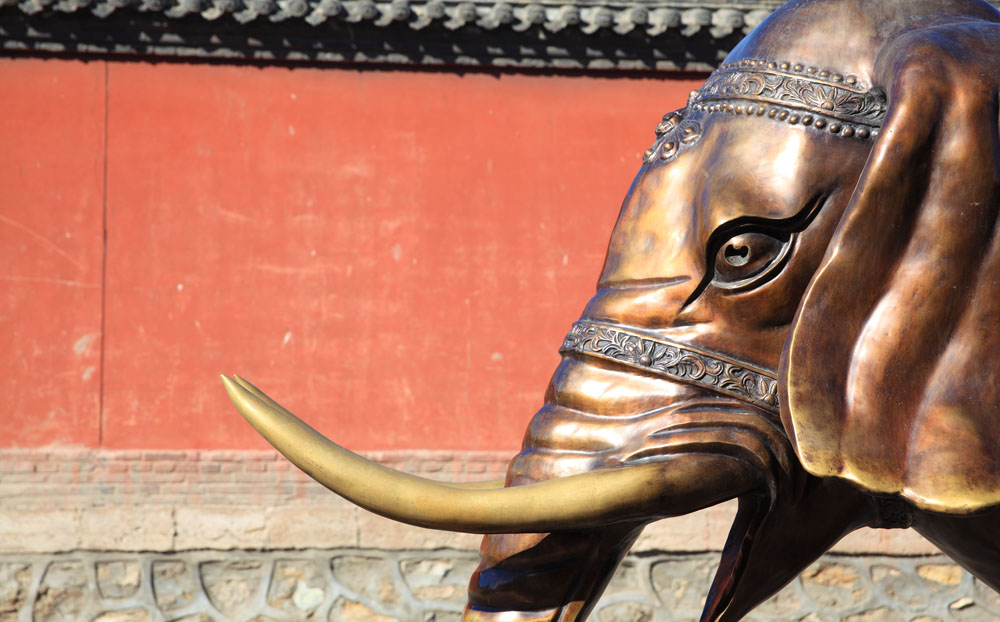Inner Mongolia Autonomous Region
Background
The region between Inner Mongolia and the provinces to its south marks the northern range of viable large-scale agriculture in China. Since ancient times, it has therefore always been a place where the cultures of the nomadic steppe dwellers and the settled Han agriculturalists met and clashed. Over the centuries, Inner Mongolia has also been a place where various nomadic tribes vied against each other for power. Recurrent warfare between the competing Xiongnu, Xianbei, Khitan, Jurchen, Tujue and other Mongol nomad tribes has been common as they jostled for control over the region’s extensive grasslands.

Five Pagoda Temple, Huhhot
Inner Mongolia was initially absorbed into the Chinese empire during the Qin Dynasty (221-206 BCE) when China first became unified as one empire. To quell the region once it had been conquered, the Qin Dynasty promoted a policy of Han immigration into the area; thousands of Han families moved north during this time. After the Qin Dynasty collapsed, its successors’ hold on the territory weakened. The Han Dynasty (206BCE-220BC) later waged war against the Mongols to reclaim the land and renewed the policy of Han settlement. The pattern of waxing and waning Han control of Inner Mongolia characterized much of its history.
In 1206, Ghengis Khan united the fragmented Mongolian tribes and then launched an attack on China. After his death, his grandson Kublai Khan continued his conquest and eventually all of China was brought under the control of the Mongol-ruled Yuan Dynasty (1279-1368). The Mongols of the 12th and 13th century were superb warriors, able to endure extreme privation, travel at astonishing speeds, and to shoot accurately at a gallop. They also effectively used terror as a weapon of war. Genghis Khan was said to have declared that there is no greater joy than slaughtering one’s enemies, stealing their horses, and raping their women. Cities that resisted Mongol rule were devastated. When Ghengis captured Zhongdu (roughly present day Beijing) in 1215, it was said to have burned for more than a month.

Begtse, Protector of Mongolian Buddhism, Thangka Painting
After the Yuan Dynasty’s fall, the divided Mongols retreated back north and resumed old raiding patterns against the Han agriculturalists and in-fighting between themselves. To defend itself, the Ming Dynasty (1368-1644) rebuilt much of the Great Wall of China, expanding it to roughly follow the southern border of the modern-day Inner Mongolia Autonomous Region, with some deviation at the Hebei-Inner Mongolia border. When the Manchus of the north conquered China in 1644 and founded the Qing Dynasty (1644-1911), Inner Mongolia once again fell under Chinese imperial jurisdiction, along with the rest of Mongolia. As the Manchus became progressively Sinicized during 1800s, they too began promoting Han Chinese farmers to settle in both Mongolia and Manchuria in order to secure their influence over these regions. At the collapse of the Qing in 1911, Mongolia declare its independence, though the territory it controlled included very little f today’s Inner Mongolia. This declaration was not accepted by any of the various Chinese administrations until the CCP did so in 1945, and then only under pressure from the Soviet Union.
Early on in the 1945-1949 Chinese Civil War which followed the end of 1937-1945 Sino-Japanese War, Chinese Communists won control over Manchuria and Inner Mongolian with the help of Soviet Russia. The Communists established the Inner Mongolia Autonomous Region in 1947. Initially, the Autonomous Region encompassed just the Hulunbuir area, today Inner Mongolia’s most north-eastern region. As the Communists consolidated their control over mainland China, Inner Mongolia was expanded westwards integrating all areas with sizable Mongol populations.
During the Cultural Revolution, a backlash against the Mongol population caused Communist Government to re-distribute about two-thirds of Inner Mongolia containing about half its population to surrounding provinces, particularly the Ningxia Hui Autonomous Region and Heilongjiang. In 1979, this restructuring was reversed, and Inner Mongolia was restored to its 1969 size.
People
In 2017, Inner Mongolia had a population of approximately 25 million people, making it China’s 23rd most populous region. The majority are Han Chinese who comprises about 79% of the population. Mongols account for just 17% of Inner Mongolia’s residents. The remaining populace includes Manchu, Hui, Evenk, Korean, and Oroqen peoples. When Mao Zedong promoted collectivization in the late 1950s, traditionally nomadic Mongols were encouraged to put down roots in permanent settlements. Over 70% of Mongols now live in less than 18% of Inner Mongolia’s area, although some Mongols still pursue traditional nomadic lifestyles. Where Mongols have resettled into urban areas, intermarriage between Mongols and non-Mongol populations happens with some frequency. There is little cultural dishonor for Mongols to marry outside their ethnicity.
Economy
According to China’s National Bureau of Statistics, in 2018 Inner Mongolia’s GDP was approximately $226 billion, the 21st largest in the country. Its per capita GDP was approximately $8,918. Overall, its GDP accounts for 1.7% of China’s total which was generated by 1.8% of China’s population. Its GDP per capita is ranked 13th out of China’s 33 provinces, municipalities, and autonomous regions.
The development of agriculture in Inner Mongolia has been restricted by a short growing season and minimal rainfall. In some areas, particularly where the Yellow River makes a large loop through the center of the province, irrigation has enabled the farming of oats, rice, spring wheat, kaoliang, millet, sugar beets, grapes, linseed, rape, and sunflowers.

Inner Mongolia Agricultural Field
More important than its agriculture is its livestock herding. Inner Mongolia has about 30% of China’s grassland and 25% of its pasture. As a result, Inner Mongolia has traditionally engaged in raising sheep, cattle, horses, goats, camel, and pigs. Some reindeer herding is also practiced in Inner Mongolia’s forested north and northeast.
Inner Mongolia’s rapid economic growth has been largely driven by its vast mineral wealth. Its large reserves of easily accessible coal and iron ore have driven its industrial development; its proven deposits of coal, alone, are one of the largest in the country. The region also has large deposits of ferrous metals, non-ferrous metals, precious metals, industrial chemicals and non-metal minerals. Some of these large deposits include salt, natural alkali, niobium, beryllium, and gypsum. More importantly, Inner Mongolia holds an estimated 80% of the world’s known reserves of rare-earth metals. Large oil and natural gas fields have also been discovered. It also has the largest usable wind power capacity in China.
Largely as the result of its resource wealth, Inner Mongolia today is one of China’s largest iron and steel producers. Other industries include ceramics, cement, machinery, automotive and trucks, textiles, energy, building materials, forestry-related industries, equipment manufacturing, leather products, chemical fertilizers, electronic equipment, high technology and nonferrous and rare-earth metals processing. Its traditional handicrafts include the manufacture of carpets, saddles, cashmere, and camel hair fabrics. Inner Mongolia also has some forestry-related industries, especially in its northeast and northern borders.
Lay of the Land

Hurts in the Mongolian Grassland
In contrast to sandy deserts of the west, large parts of central Inner Mongolia consist of rich grasslands which support herds of livestock, most especially horses and sheep. Moving east, Inner Mongolia elevation begins to rise. The Da Hinggan Range covers most of the eastern third of the autonomous region, reaching elevations of 1,200 meters and more. Through the glacial valleys of these mountains, the many tributaries of the Argun River run. The Argun River in turn is an important tributary of the Amur or Heilong Jiang River; it runs along most of the border dividing Inner Mongolia from Russia. Forests blanket large areas of east, supporting Inner Mongolia’s forestry industry. Coniferous species such as pine are found in the northern Da Hinggan (sometimes known as Da Xing’an) Mountains while deciduous birch and aspen are more common in the south.
Due to its extensive and varied territory, Inner Mongolia has a wide variety of regional climates. That said, winters throughout the region are long and cold, although the snowfall is often light. In the west, spring can be characterized by sudden and dangerous sandstorms. Summer is warm to hot and is when most of the rain falls.
Interesting Aspects for a Traveler

Traditional Life near Taipusi Town
The capital of Inner Mongolia is Hohhot (known as Huhehaote in Chinese) which translates from the Mongolian as Blue City (though not in Chinese), a reference to the endless blue skies that arch over the grasslands that surround it. Although the city was first founded in the 16th century, the city is now primarily modern, although some traditional mud-brick houses can still be found in its south, and the Old City retains a feel of a former era. Its Inner Mongolia Museum displays an excellent although hodgepodge collection ranging from dinosaurs to Genghis Khan paraphernalia. The Qing-era Great Mosque is a fusion of Chinese and Arab architectural influences; the area surrounding the Mosque is a maze of narrow, interesting alleys. The Xilitu Zhao is a Ming-era Buddhist shrine which has served as the official residence of several incarnations of the Grand Living Buddha starting with the 11th Grand Living Buddha in 1735. Although destroyed by fire in the 19th century and then further damaged during the Cultural Revolution, it is still an active temple.
Built originally in 1579 Da Zhao is Hohhot’s largest Buddhist temple and houses an extensive collection of musical instruments, dragon sculptures and a 3 meter high silver Buddha amongst its other treasures. The 1727 Wu Ta Si or Five Tower Temple has a base with over 1500 images of Buddha carved into its walls. The Wusutu Zhao Buddhist monastery showcases Ming-era murals and woodcarvings with imperial dragon motifs. Bai Ta is a 10th century wooden and brick Octagonal structure built originally to house ancient Buddhist scriptures; a staircase at the top offers panoramic views.
The three grassland areas closest to Hohhot include Xilamuren, Huitengxile and Gegentela; although highly touristy now, they do nevertheless still provide insight into traditional Mongolian nomadic life and a sense of the arresting landscape of the Mongolian steppe.

Map of the People’s Republic of Mongolia
To the east of Hohhot lies Baotou, Inner Mongolia’s largest city and its most important industrial hub. Donghe, the oldest part of the city, lies to Baotou’s east. It still has some streets lined with mud-brick houses adding some flavor to what is otherwise a largely plain industrial city.
130 km south of Baotou, is the Ghengis Khan Mausoleum. Despite its name, Ghengis Khan is not buried in the Mausoleum; in fact the Mausoleum houses only replicas of Ghengis Khan’s personal effects as the real effects have long since been lost or stolen.
Northeast of Baotou is the 1749 Wudang Lamasery – a monastery of lamas – once the largest monastery in Inner Mongolia. Around 50 monks still live in the Lamasery today.
West of Baotou is the 1650 Cave Temple, one of the oldest monasteries in Inner Mongolia built into caves set into the Yinshan Mountains. Destroyed during the Cultural Revolution, it has now been largely restored.
Badain Jaran Desert offers a great variety of landscapes and sites to explore including its hundreds of spring-fed oasis lakes, the largest sand dunes in the world and ancient Buddhist temples. Areas of its sand echo like thunder for miles.

Bronze elephant, Da Zhao Monastery, Hohhot
East of Hohhot is Shangdu or Xanadu, the site of the famous summer palace of Kublai Khan which was extolled in Samuel Taylor Coleridge’s poem: “In Xanadu did Kublai Khan a stately pleasure dome decree.” Today there is little left of the palace but the ruins of its walls, but it is set in wild prairie which gives a sense of vast unending space despite it being only 275 km northwest of Beijing.
Close to the Russian border, Haila’er is Inner Mongolia’s largest northeastern town. A modern city, for travelers it is now mostly known for its network of tunnels built by Chinese prisoners for the Japanese during the 1937-45 Sino-Japanese War, complete with tanks, guns and a museum to explore.

